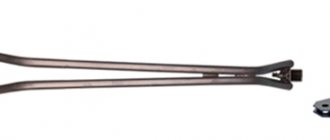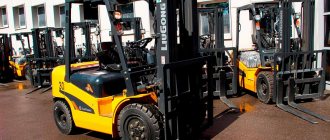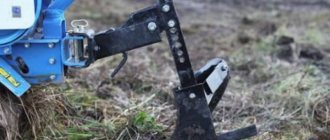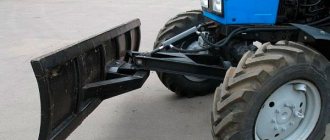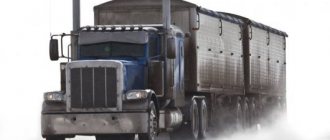Purpose and types of adapters
An adapter is a trailer that increases the functionality of small-scale mechanization equipment.
It has a frame and a wheel axle. With its help, a walk-behind tractor is converted into a full-fledged mini tractor that is capable of plowing and planting. In this case, the tillage speed increases from 5 to 8−10 km/h. In addition, the adapter gives the walk-behind tractor stability and the ability to fully use agricultural implements. Almost all adapters have a driver's seat and levers that lift agricultural implements. This mechanism has footrests and a brake pedal that locks the wheels when stopping. All parts are mounted on a durable frame.
A hitch is located in front or behind the adapter, allowing you to connect the entire structure to the walk-behind tractor. In addition, many devices are equipped with an additional coupling mechanism. It is convenient to hang equipment for cultivating the soil on it.
There are two main types of design:
- With movable joint. It is also called a fracture adapter. This is the simplest device and the easiest to make. In it the hitch is located in the front part. But in this case, controlling the walk-behind tractor will be more difficult, since you will have to turn the entire power unit completely.
- With steering gear. Here the joint between the adapter and the walk-behind tractor is rigid, and control is achieved through the built-in steering unit. This design is the most convenient to use, but difficult to manufacture.
In addition, adapters are available with body and without body. The design of the bodywork includes a metal box measuring 130 x 110 x 80 cm, intended for transporting tools and crops. Bodyless ones are the simplest ones; they are needed only for hanging land-cultivating equipment.
Therefore, when making a homemade adapter for a walk-behind tractor, you need to have a good understanding of the goals and objectives of this device, as well as know what materials and spare parts are available. If necessary, you need to collect all the missing parts.
Recommendations for use
Regardless of the type of assembled and connected product, you need to start working with it by taking into account safety regulations. Before starting the engine, you need to conduct a visual inspection of the equipment to eliminate visible damage and malfunctions. Do not add fuel to the fuel tank while the engine is running.
If you hear an unusual noise when you turn it on, you need to stop the engine and identify the cause of the problem.
Do not use gasoline of inappropriate brands or fuel mixed with oil and other impurities. Before each start, you need to check the oil level, since this is often the reason the engine stops.
In order to extend the service life of motorcycles, a new product must be run-in. It will contribute to the trouble-free functioning of the walk-behind tractor.
During this process, the working surfaces of the parts are usually worked out. The duration of running-in, as a rule, varies for products of different brands and modifications. In some varieties it can be up to 20 hours or more. At this time, you should not load the equipment to the maximum extent.
One recommendation is to change the oil after the first five hours of operation. As for warming up the engine, this should be done at medium speeds without load for about three minutes.
Based on the modification of the walk-behind tractor, for the first hours of its operation it is necessary to operate the unit in first gear (with the gas lever in the middle position). It is important to try to avoid not only maximum, but also minimum speed . At the end of using the equipment, you need to check the tightness of the threaded connections.
As for the cultivated soil, it is better to cultivate simple soil in the first hours. In addition, you need to take into account that rolling in is not done on rocky and clay soil.
Before work, you need to inspect the area and remove stones and large debris. In general, when working with motorized equipment, you need to constantly monitor its cleanliness and check the fastening strength of the accessible elements of the adapter and walk-behind tractor, including attachments.
Don't forget to tighten any loose fasteners. You also need to remember about timely maintenance.
Preparing for work and reviewing elements
The adapter is, without a doubt, a very important component of the walk-behind tractor, so it must be reliable and convenient. There are several points to pay attention to:
- Coupling mechanism. It must be durable and have the necessary rigidity. Therefore, it is always made of cast iron or steel. The gaps in the connection nodes should be minimal, since this affects the strength of the fixation of the connecting element.
- Material for production. Based on operating experience, it is clear that adapters made from sheet steel are the most reliable. They are assembled using a welding machine. At the same time, the quality of the welds must be ideal. Otherwise, during operation it will be because of them that a breakdown will occur.
- Driver's seat. The seat is made to be comfortable and adjustable in height, because you will have to spend several hours in a row in it while working.
If these conditions are met, production begins. First, make your own drawings of the hitch for the walk-behind tractor or choose suitable ones on the Internet. After all, the more diagrams and drawings you study, the better the result.
Manufacturing a device with a movable joint
This is the simplest device. The adapter itself will be located behind the walk-behind tractor. It is not difficult to make, but the process requires attention and concentration. The service life of the mechanism depends on the quality of work. This adapter is suitable for heavy walk-behind tractors, for example, “Neva”. It has an engine power of over 7 hp. With. and weight from 105 kg. This allows you to pull not only the adapter, but also agricultural implements without slipping.
For manufacturing you will need the following materials and tools:
- electric drill with the necessary set of drills;
- DC welding machine and electrodes;
- grinder with a set of cutting and grinding discs;
- hammer, file, square, various hardware;
- sheet metal with a thickness of at least 5 mm;
- several profile pipes measuring 40 x 50 and 50 x 50 mm;
- round water pipe with thick walls with a diameter of 30−45 mm;
- steel rods with a diameter suitable for a round pipe;
- channel 40 x 50 mm;
- two wheels from a Zhiguli or Oka with bearings and hubs;
- driver's seat.
You can choose any adapter size, but based on the needs of the mini-equipment. The frame itself can be made slightly higher or lower than the axis of the walk-behind tractor. For wheels, the optimal suspension is portal, providing decent ground clearance. It is not necessary to install shock absorbers on the adapter - this complicates the design. The easiest way is to take a seat with built-in elastic elements.
Next, they proceed directly to the manufacture of individual units .
- Hitch. This is a welded mechanism, which is a hinge that operates in two planes. It is then installed into the base of the adapter frame and bolted to it. It consists of two pieces of 40 x 50 pipes welded to each other and a piece of round water pipe. A welded tee is inserted into it. The tee itself consists of a rod and part of the same pipe. This is the most critical unit, so the welds must be perfect.
- Adapter frame. Here you will need a profile pipe and channel. They are welded together, strengthened, and then made into racks for the wheels. Next, the racks are fixed with braces welded to the frame and wheel hubs. Install and secure the wheels.
- Several pieces of pipe are welded to the main frame to install the seat.
- Fix and adjust the seat. It is placed so that when the steering wheel is turned, the operator’s back does not leave the backrest. There is no need to remove the walk-behind tractor controls - this is done when the power plant is located behind the driver.
- Install the finished coupling device.
- Attached to the walk-behind tractor.
A bracket for attachments is made. It is located on the rear cross member of the frame. To do this, add several levers and rods that will change the lifting height of agricultural implements.
Next, the wheel locking mechanism is made. To do this, use a ready-made brake system from any passenger car and fit it to the installed wheel hubs.
Arrangement of a multifunctional model
To manufacture a multifunctional device, you need to prepare:
- Steel pipes and angles;
- Sheet steel;
- Two wheels;
- Comfortable seating;
- Welding machine and set of tools.
This adapter is a multifunctional model. It can be used for basic agricultural work and transporting goods over uneven terrain over short distances. The structure can be equipped with agricultural implements such as a plow, harrow, hiller, and potato digger. During the winter months, you can attach a snow scraper to the adapter for clearing snow.
The main elements of the equipment are: frame and coupling devices, as well as wheelset and seats
The process of producing an adapter at home takes place in several stages.
Stage #1 – drawing up a kinematic diagram
To ensure the balance of the structure and prevent additional overloads at the design stage, it is necessary to draw up a kinematic diagram. You can make it yourself or use a ready-made version.
This circuit is designed for the manufacture of an adapter designed to work on the Neva walk-behind tractor.
Stage #2 - production of main parts
When making and assembling a frame, it is important to provide for the arrangement of a fork with a bushing. It is necessary to ensure free rotation of the trailer
The frame of the structure is made of metal pipes and angles
The body of the structure is made of steel sheet. The height of its sides is made no less than 30 cm.
When making stands for the adapter wheels, you can use the diagram below.
The simplest option for manufacturing a coupling assembly is a 15 cm long pin, which is stuck into the hole in the drawbar of a U-shaped walk-behind tractor. The disadvantage of this option is rapid wear: under the influence of a freely rotating trailer, the holes for the hitch quickly break. To reduce wear, it is advisable to lengthen the U-shaped chain.
Walk-behind tractor with steering control
With this method, the power unit will be located behind the driver and rigidly attached to the front adapter.
Consequently, the coefficient of adhesion of the driving wheels to the soil will increase. This, in turn, will increase traction force, which will make it possible to work with any attachments. For such experiments, the light Salyut walk-behind tractor, which weighs about 75 kg and has a power of 6.5 liters, is best suited. With. In this case, you will need a steering column with a gearbox. But this is for this case, if you dare to make a walk-behind tractor with front steering. This procedure is much more complex and painstaking than a simple joint, but the result will please you - you will get a walk-behind tractor with a steering wheel and a seat, and all the necessary levers will be at your fingertips.
During manufacturing, you will need not only a steering wheel and gearbox, but also steering rods with coulters . You will definitely need gas, clutch and brake pedals located under your feet. They are connected to standard controls with homemade rods or steel cables.
Design features of front and rear adapters for walk-behind tractors
Many farmers use walk-behind tractors to work in their fields. The adapter for the walk-behind tractor makes it possible to speed up its execution. This unit is used as a trailer that moves on wheels and is attached to a motor cultivator. You can add attachments to the device and mount a chair. Often gardeners make such a unit themselves.
Purpose
An adapter for a walk-behind tractor was created for the convenience of gardening. If you attach a hinge to it, you can expand the scope of application of the device:
- remove hay;
- level the soil surface;
- transport goods;
- harrow the ground;
- clear the area of snow.
An adapter is a device that is designed for movement on a motor cultivator. With it, you can control the unit while sitting in a chair, and at the same time cultivate the soil. The trailer for the Neva motor-cultivator is equipped with a steering control. It makes it easier to use the walk-behind tractor.
You can install different attachments for harvesting, a plow, a mower, etc.
This trailer speeds up work in the field. Using this design, you can increase the speed of the cultivator from 5 to 10 km/h. Let's look at the adapter device. The adapter for the motor cultivator consists of:
- frames;
- operator seats;
- two wheels;
- axles;
- coupling mechanism.
After attaching the adapter, the cultivator looks and is used like a mini-tractor. To create an adapter for a cultivator with front steering, you need a frame. The operator's seat is installed on it. The frame is fixed to the chassis.
The seat is fixed to the frame. This will make it easier for the operator to control the cultivator. The wheel system will help move the unit around the site. There are 2 types of wheels: metal (used in the field) and rubber (used for driving on the road).
The hitch for a walk-behind tractor is made of steel or cast iron by welding. She attaches the cart to the cultivator. The U-shaped fastening system is considered the best. With this design the device will be stable.
- The highest travel speed on a walk-behind tractor with a trailer is 12 km/h.
- Maximum load capacity - 100 kg.
- The track diameter is 67 cm.
- Dimensions are 130x70x71 cm.
- The weight of the device is 22 kg.
- The warranty period is 5 years.
Types of adapters for walk-behind tractors
The adapter for the walk-behind tractor comes in several types. The design is distinguished by the coupling method:
- Strong connection to the motor cultivator. The device has a separate steering wheel. Steering wheels are located at the front or rear (both options are possible).
- Movable connection. At the same time, the angle between the cultivator and the cart changes all the time. Turning requires a lot of effort due to the fact that the connection point is movable.
The devices are also divided according to the presence of drive wheels into:
- Front. The hitch assembly is located at the rear.
- Rear. The hitch assembly is located at the front.
Trailers are divided into:
In addition to garden work, universal ones are useful for transporting crops.
Trailers are divided according to the size of the drawbar:
Structures with a short drawbar are attached to low-power walk-behind tractors. Trailers with a long drawbar are attached to powerful cultivators.
There are 2 types of trailers: on 1 axle or on 2 axles. These couplings are created by the manufacturer. The factory calculated such a design and mounted a tow bar on it. A spring was installed under the seat, designed to allow the vehicle to move smoothly on rocky surfaces.
The APM has special footrests and a brake that is pressed with the foot to stop the cultivator. Pneumatic tires were mounted on the adapter, which ensure smooth running at high speed.
You can buy the device in a specialty store unassembled in packaging. It's easy to assemble. There are instructions for this. To assemble the device, no additional knowledge or skills are required. Afterwards you need to check how the design works.
If all components work well, you can start operating the device. When purchasing a design, you also need to choose a soft lining for the seat. Then the driver's work will become more convenient. The HorseAM IS 1 adapter for the Magnum walk-behind tractor, and adapters for the PNO-1, AM-3 K, BUM-3, KTZ-03 cultivators are very popular among farmers.
With steering
A high-quality adapter with a steering wheel for a walk-behind tractor makes it easier to control the cultivator. In terms of its functions, such a walk-behind tractor is comparable to a mini-tractor, only it is more economical in fuel consumption. The standard APM unit does not have a steering wheel.
Control is carried out using the cultivator steering wheel. But other manufacturers produce units with steering. The trolley is designed for more convenient work on the cultivator, so the presence of a steering wheel will make control easier.
With movable joint
When a trailer is movably coupled to a motor-cultivator, the angle of the vertical axis between the cart and the cultivator changes. It is easier to make such a device, but when turning it will be necessary to apply more force. This type of trailer is inferior in geometric characteristics: the turning radius becomes larger.
Front and rear adapters
There are several types of trailers depending on which wheels are driving:
- Front-wheel drive. The unit is fixed at the back of the walk-behind tractor. This is the simplest and most popular modification. It makes it possible to easily control the cultivator and perform a large amount of work.
- Rear drive. The unit is located in front of the cultivator. This design makes it possible to perform work when using a hitch located at the rear of the cultivator.
- Four-wheel drive. The trailer can be located either in front or behind the cultivator. This design differs from the previous ones in that not 2 wheels rotate, but all 4 at once. This device performs the functions of a mini-tractor. At the same time, the maneuverability of the structure, its maneuverability increases, and additional traction with the soil is provided. The 4x4 drive is considered the most efficient.
How to install?
Let's look at the principle of installing an adapter with a steering wheel using the example of a model for a KTZ walk-behind tractor with a steering column. Connecting the adapter to the walk-behind tractor begins with installing the trailer on the pin of the walk-behind tractor, which is located in its front part. The knot is secured with a cotter pin. After this, you need to move the gas to its place under the seat, carrying it with the original cable. To do this, use a 10 mm wrench and a screwdriver, remove the throttle control lever, remove the top plug under the seat, and lay the cable. If necessary, change the bolt, since depending on the adapter model, it may be larger than necessary.
Next, tighten the bolts with a 10mm wrench. When moving the gas, make sure that the cable does not interfere anywhere. Remove the steering wheel from the walk-behind tractor and unhook the clutch and gearbox release cables. Next, remove the steering wheel using a stand for ease of use. Having removed the steering wheel, remove the support and begin installing the pedals. At this stage of work, use a cable with an adapter plate, which is included with the adapter.
The plate is installed on the wing of the walk-behind tractor and secured with a bolt and nut. The lever screwed to the cable is placed in place of the roller bracket. After this, install the second cable, secure it and attach it to the installed bracket, fix it until the moment allows the cable to move.
Now you need to set the forward gear to the right pedal. There is no need to remove it for this. At the same time, adjust the components, checking the forward tension . After this, reverse is installed.
How to make an adapter for a walk-behind tractor with your own hands
A gardener or farmer who wants to increase the volume of work can make an adapter for a walk-behind tractor with his own hands. Let's look at how to make a front adapter with a steering wheel yourself. To do this, a frame is made, a lever is welded to it, then a coupling unit is created, after that the trailer rotation mechanism is made, then the braces need to be welded.
In this way, you can make a homemade all-wheel drive trailer for both small and heavy walk-behind tractors. Let's look at step-by-step instructions for making a trailer yourself below.
Scheme and design elements
To make an adapter with your own hands, you must first complete the drawings and diagrams of this device. And using a ready-made diagram indicating all the parts, assemblies, structural elements and their dimensions, it will be easier to start making the unit yourself.
Required materials and tools
Let's consider what is needed to create the device.
Materials and tools:
- Two wheels with an axle. The radius of the wheels should be 15-18 inches. You can take wheels from a car.
- Bearings for wheel and steering systems. Metal profile corner or channel, metal pipe.
- Nuts, screws, washers.
- Lubricant: grease.
- Welding machine, drill with drill bit, wires, disks.
- Bulgarian.
- Screwdriver, wrench, screwdriver.
- Frame for turning the cultivator using the steering wheel.
Drawings and dimensions
First you need to complete the drawing. First of all, the kinetic scheme is calculated. Then they carry out the basic diagram, which shows the dimensions of all parts. All parts, components and fasteners of the structure will be manufactured according to this scheme. Before you start creating the unit, you need to clarify all the data available on the diagram and check their compliance with the indicators of all workpieces.
Arrangement of a multifunctional model
To manufacture a multifunctional device, you need to prepare:
- Steel pipes and angles;
- Sheet steel;
- Two wheels;
- Comfortable seating;
- Welding machine and set of tools.
This adapter is a multifunctional model. It can be used for basic agricultural work and transporting goods over uneven terrain over short distances. The structure can be equipped with agricultural implements such as a plow, harrow, hiller, and potato digger. During the winter months, you can attach a snow scraper to the adapter for clearing snow.
The main elements of the equipment are: frame and coupling devices, as well as wheelset and seats
The process of producing an adapter at home takes place in several stages.
Stage #1 – drawing up a kinematic diagram
To ensure the balance of the structure and prevent additional overloads at the design stage, it is necessary to draw up a kinematic diagram. You can make it yourself or use a ready-made version.
This circuit is designed for the manufacture of an adapter designed to work on the Neva walk-behind tractor.
Stage #2 - production of main parts
When making and assembling a frame, it is important to provide for the arrangement of a fork with a bushing. It is necessary to ensure free rotation of the trailer
The frame of the structure is made of metal pipes and angles
The body of the structure is made of steel sheet. The height of its sides is made no less than 30 cm.
When making stands for the adapter wheels, you can use the diagram below.
The simplest option for manufacturing a coupling assembly is a 15 cm long pin, which is stuck into the hole in the drawbar of a U-shaped walk-behind tractor. The disadvantage of this option is rapid wear: under the influence of a freely rotating trailer, the holes for the hitch quickly break. To reduce wear, it is advisable to lengthen the U-shaped chain.
Stage #3 – seat installation
The seat is secured to the spinal frame of the adapter beam, stepping back 80 cm from the front edge. It is fixed with bolts. The adapter is ready. All that remains is to check the functionality of the multifunctional device.
Owner reviews
On forums, adapter owners express their opinions on the use of this design, its characteristics and how you can make the device yourself. Here are reviews from some owners of this equipment.
Sergey Petrovich, 53 years old, farmer
For several years, when using a walk-behind tractor, I had to constantly walk behind it and hold it by the handle. Our site is located at a great distance from the house. Therefore, on the advice of friends, we purchased an adapter that comes with a steering wheel and a seat. Now it has become convenient to work. Labor productivity has increased. In addition, with the help of the new device it is possible to transport crops over long distances.
Victor, 42 years old, summer resident
Great difficulties were experienced when clearing snow in winter. For this purpose, we used a walk-behind tractor and a snow blower that is mounted on it. My neighbor helped me make drawings and assemble the design of the adapter for the walk-behind tractor. After the device was manufactured, snow removal work became much easier. The trailer turned out to be durable and reliable.
Advantages and disadvantages
Adaptive steering of a walk-behind tractor is convenient because:
- eliminates the need to walk behind motor vehicles;
- the traction potential of the walk-behind tractor is fully realized;
- the functionality of agricultural equipment increases;
- transportation of the unit to a specific processing area is simplified;
- easier control - no longer requires a lot of operator effort;
- the structure can be disassembled if necessary;
- sufficient balance is achieved on all axes.
The disadvantages include an increase in fuel consumption, which after modification takes one and a half times more. However, these losses are justified by the ease of management and saving a colossal amount of time that the gardener spends when working with the land.
Making an adapter for a walk-behind tractor with your own hands
Any activity on a plot of land takes a lot of time and effort. For this reason, gardeners are increasingly using special equipment, such as walk-behind tractors. However, it is impossible to do everything with this unit. Without a special adapter, you will not be able to weed or hill up the ground, or clear the area of snow and construction debris. A cart with a seat for a walk-behind tractor nowadays costs quite a lot of money. However, there is a way out. Today we will talk about how you can make a homemade adapter for a home walk-behind tractor without any special effort.
Description of the adapter for the walk-behind tractor
The adapter is a special module for moving on a walk-behind tractor. With its help, you will be able to operate the unit in a sitting position and at the same time cultivate the land. For example, the adapter for the MTZ walk-behind tractor has steering control. It is quite possible to do it yourself. One of the sections of the article below is devoted to how this can be done. In the meantime, let's talk about the purpose of this attachment.
Using an adapter can greatly simplify the use of this home appliance. You will have the opportunity to change attachments for hilling or planting potatoes, a flat cutter, a plow and other devices. The adapter also speeds up absolutely any garden work . In other words, if such a device is used in practice, the speed of the workforce will increase from 5 to 10-11 km/h.
Adapter for motor blocks
Most often, the adapter has two hitches - one is used to attach additional attachments, and the second makes it possible to attach it to the walk-behind tractor. For example, you can connect the following additional elements to the adapter:
- seeder;
- plow;
- hillers;
- harrow and other equipment.
https://youtube.com/watch?v=6QhaZFG4wzg
The wheelset and axle in the adapter are quite durable structures that allow the walk-behind tractor to be used even on the most difficult areas of the earth, as well as for transporting quite heavy loads
It is important to understand that transporting goods on public roads using such a unit is prohibited, for this reason they are used only in rural areas. However, despite a certain structural similarity between all adapters, they are also endowed with some significant differences
For example, rear steering adapters, all-wheel drive adapters and front units are available for sale.
Adapter design features
This attachment includes:
- frame;
- driver's seat;
- a pair of wheels;
- wheel axle;
- coupling device.
That is, the adapter gives the impression of a cart that is attached to the main equipment. As a result, it looks like a mini tractor.
Now let's talk about each component in detail.
- To make a front adapter for a walk-behind walk-behind tractor with your own hands, a frame is required. The body or driver's seat is attached to it. The frame is mounted on the chassis.
- For ease of use, a driver's seat is attached to the frame. This is designed to make it pleasant and easy to operate the equipment during gardening work.
- The wheels and axle make it easier for the operator to garden with this small tractor.
- There are two types of wheels for a home tractor - rubber and metal. Metal wheels can be used for reliable work in the fields. Rubber wheels are equipped with a deep tread pattern. This way they can allow the operator to move the unit on unpaved roads and, if necessary, off-road. In any case, the wheels for the adapter are supplied with the purchase as part of the equipment itself. But if the user wants to change them, you need to pay attention to their type and size.
- Device for coupling (fastening) with a walk-behind tractor. The mount for the MTZ unit is made of steel or cast iron, using welding. The hitch is one of the essential components of the units. It provides a reliable connection to the part with the motor of the trailed equipment. The U-shaped attachment point is considered the most commonly used, because thanks to this device the vehicle is more stable.
Instructions for making the adapter
Now we’ll tell you how to make a front adapter with steering for your small tractor yourself.
To produce an adapter for a walk-behind walk-behind tractor, you will need the following materials:
- Two identical wheels on an axle. The radius of the wheels ranges from 15 to 18 inches. Even wheels from an old Soviet Volga might work.
- Bearings for steering wheels and columns.
- Steel for the frame (channel, pipe or angle).
- Fastening elements (washers, bolts, nuts).
- Lubricants (litol or grease).
- Consumables (drills, electrodes, discs for grinders).
- Set of wrenches.
- Bulgarian.
- Welding machine.
- Drill.
Maintenance and storage
As a rule, you need to check the oil level every time you turn it on, and replace it at least once every six months. The air filters are checked before turning on the unit. Clean it when it gets dirty or once every three months. The sump tank is cleaned every six months. If it is necessary to replace consumables, they try to buy original parts or those with similar quality characteristics.
They will help extend the life of agricultural equipment and will not cause engine failure. As for cleaning the air filter, this is necessary to maintain the working condition of the carburetor.
Do not use a solvent with a low flash point for this, as this is flammable and can lead not only to a fire, but also to an explosion. You cannot use equipment without an air filter, because this causes accelerated engine wear.
Repairs are carried out in a well-ventilated area with the engine turned off. In this case, it is necessary to ensure a sufficient level of ventilation in the work area. Exhaust gases are hazardous to human health and inhalation can be fatal. Motor vehicles should be stored in a dry, ventilated area .
During the summer season, it is not recommended to leave it outside, especially if the base of the operator’s seat is made not of plastic, but of wood. In order to extend the quality and performance characteristics, when storing the unit outdoors, you need to cover it with a tarpaulin cover.
If you do not plan to use agricultural machinery for more than three months, gasoline is poured out of the fuel tank, it is cleaned, and the position of the gas lever is checked. If necessary, disconnect the wheels.
The following video is about the adapter for a walk-behind walk-behind tractor.
Working on a walk-behind tractor with steering control
Let's say a few words about the control features of a walk-behind tractor with a steering wheel, and why it is recommended to use this option during assembly. It’s not for nothing that this type of conventional and home-made machines is so popular, because it has a lot of advantages:
- the operator will not have to waste his energy walking behind the mini tractor;
- the traction potential of the equipment is realized one hundred percent;
- such a mini tractor is more maneuverable and functional;
- Now, in order to cultivate a plot far from home, you will not have to additionally transport a walk-behind tractor - you can simply drive it, like a regular car or tractor;
- control is more lightweight and convenient than other types;
- Now you don’t need to hold the entire mass of this heavy and bulky device in your hands,
- it becomes possible to quickly assemble and disassemble the unit;
- control parts are not significantly modified during rework;
- good balance in weight along the axes.
We will not mention here the noise of operation and other characteristic features of, in principle, all tractors . Let's just talk about one characteristic drawback - not very reliable stability, which is associated with a movable coupling. However, the advantages are, of course, more impressive.
DVR with radar detector: rating of the best, reviews and testimonials
As noted earlier, driving a walk-behind tractor is permitted by law without a driver’s license, since it does not belong to a vehicle.
For personal safety, it is recommended to have a license with category “A” - this means a document granting permission to drive motorcycles. Admission to driving a vehicle with a small engine capacity is considered a special feature. Small agricultural machinery has minimal power.
A driver's license will make communication much easier
Owners of summer cottages do not have to worry about penalties, since the device is used exclusively for solving personal problems. However, for business companies it is necessary to obtain a passport for the equipment. The document will also be required when driving along the side of the road.
If agricultural machinery is the property of a hired worker who is used to travel to work, it is necessary to first obtain a pass from the employer.
In this case, an administrative offense can be avoided. It allows you to drive on uncongested roads that are directly adjacent to the organization. The only condition is the absence of a traffic violation or obstruction of driving.
Homemade version of a mini tractor
Types of adapters for walk-behind tractors
There are several types of adapters for mini tractors, including homemade ones.
- With lifting lever. The presented type of suspended equipment will simplify control and movement around the site.
- For transporting goods. They are equipped with special bodies that can withstand maximum loads.
- With long or short drawbar. The short type is for a lightweight type, the long type is for a heavy mechanism.
- With telescopic drawbar. This design allows for width adjustment.
This technique is also divided by type of design:
Adapter with steering
The presented type assumes rigid fixation on the walk-behind tractor. The steering gear is carried out in the format of a separate independent unit. In addition, a pair of wheels, which acts as a steering gear, is installed both at the front and at the rear. Each of them is tailored to personal preferences. The position of the steering gear is also related to spare parts, daily use. Operating a “home” mini-tractor with a homemade adapter is no more difficult than, for example, an ATV.
Adapter with movable hitch
Involves a movable connection of the trailer to the walk-behind tractor.
This system is more difficult to control, but making such a module with your own hands is much easier. Requires more effort when turning. The module can be mounted either rear or front. Even the primitive structure of a walk-behind tractor involves load distribution. Therefore, it is recommended to place the seat in the module near the drive axle. Under the weight of the operator, the wheels of the walk-behind tractor will be pressed to the ground, which prevents slipping during movement. There is nothing complicated in designing an adapter and working with a mini tractor. This is available to anyone who has set out to get a home tractor on their plot, which will make a person’s work easier every day. So try to design, build and create - and cultivate the land with pleasure.
vote
Article rating
Details about the hill start assist system: what it is, how it works
In Russia, many craftsmen make their own walk-behind tractors. Naturally, such equipment does not have any passports, certificates, or legal justification for its operation.
However, you can use the equipment for your own needs, on your own site, for personal purposes. Here, again, you can rely on Order No. 807 of the Russian Ministry of Agriculture, which clearly states that a walk-behind tractor is not a tractor.
But it’s not worth going out on public roads with such a device again. Traffic police officers may try to identify a whole “bouquet” of violations, including lack of registration, driving without the appropriate driver’s license, etc.
Since there is no technical passport, it is impossible to prove that the walk-behind tractor is a walk-behind tractor and not a tractor. Accordingly, representatives of the law may try to demand the rights of a tractor driver.
Therefore, you should not go on busy roads, and it is better to drive on rural roads only if necessary. Because you will have to prove your case in the courts.

